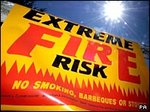The National Fire Service (NFS) was the single fire service created in Great Britain in 1941 during the Second World War; a separate National Fire Service (Northern Ireland) was created in 1942.
The NFS was created in August 1941 by the amalgamation of the wartime national Auxiliary Fire Service (AFS) and the local authority fire brigades (about 1,600 of them). It existed until 1948, when it was again split, with fire services reverting to local authority control, although this time there were far fewer brigades, with only one per county and county borough.
The NFS had both full-time and part-time members, male and female. Its uniform was the traditional dark blue double-breasted tunic, and it adopted the peaked cap worn by the AFS instead of the peakless sailor-style cap which had been worn by many pre-war fire brigades (including the
London Fire Brigade). The peaked cap was retained by fire services after the war.
When they were on duty, but in the frequent long stretches between calls, many firemen and firewomen performed vital wartime manufacturing work, in workshops in the fire stations or adjacent to them. This was entirely voluntary, but since many of the wartime personnel had worked in factories before the war it was work with which they were familiar and skilled.
The Chief of the Fire Staff and Inspector-in-Chief throughout the war (until 28 February 1947, when he retired) was Sir Aylmer Firebrace, former Chief Officer of the London Fire Brigade.
At peak strength the NFS had 370,000 personnel, including 80,000 women. The Fire Services Act 1947 restored fire services to local authority bodies in 1948.
RanksMen * Fireman
* Leading Fireman
* Section Leader
* Company Officer
* Senior Company Officer
* Column Officer
* Divisional Officer
* Assistant Fire Force Commander
* Fire Force Commander
* Chief Regional Fire Officer
* Chief of the Fire Staff
Women * Firewoman
* Leading Firewoman
* Senior Leading Firewoman
* Assistant Group Officer
* Group Officer
* Assistant Area Officer
* Area Officer
* Regional Woman Fire Officer
By
Wikipedia


